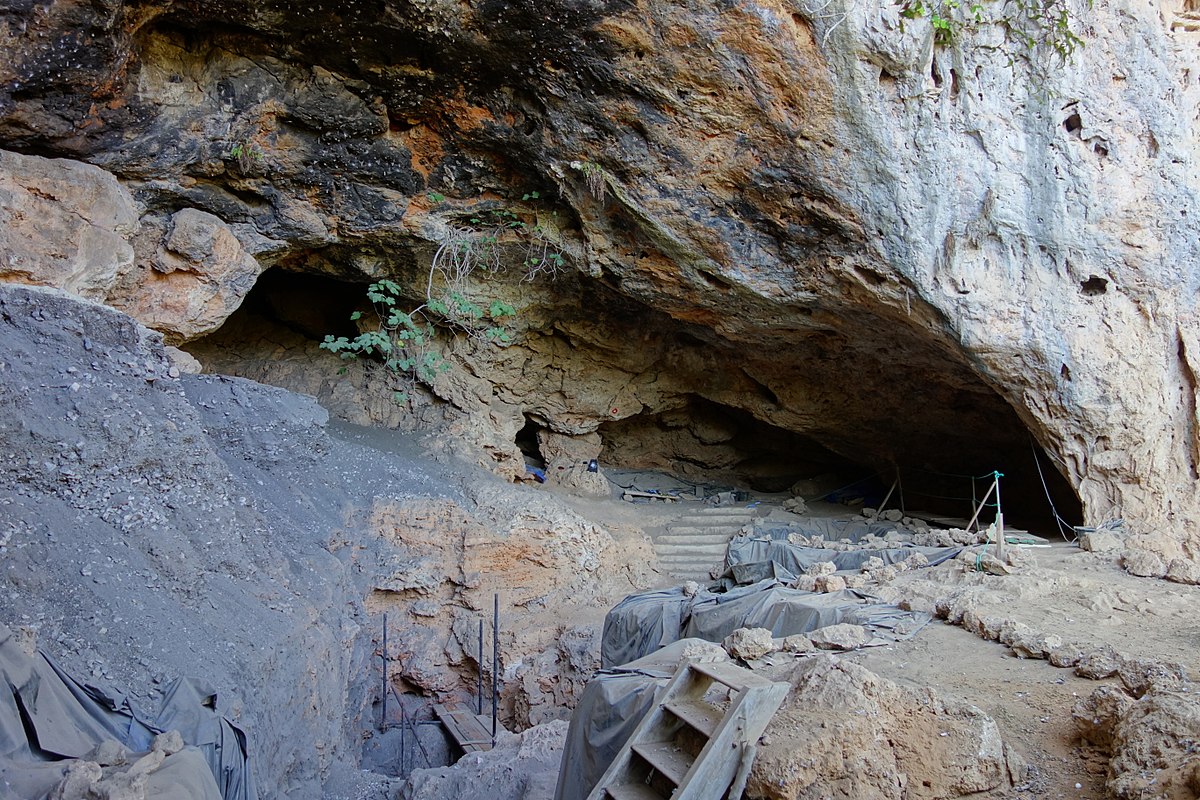The egyptians themselves believed they originated in nubia or punt. The predynastic egyptians had some stronger cultural ties with nubiaWerent the original Egyptians cushites or is that just another myth?
You are using an out of date browser. It may not display this or other websites correctly.
You should upgrade or use an alternative browser.
You should upgrade or use an alternative browser.
GENETICS New Nubian genetic study [Christian Early Medieval Period]
- Thread starter Apollo
- Start date
Apollo
VIP
The egyptians themselves believed they originated in nubia or punt. The predynastic egyptians had some stronger cultural ties with nubia
I think the further back you go in time in Egypt the more similar they become to this population:

Taforalt - Wikipedia
 en.wikipedia.org
en.wikipedia.org
Oldest North African genomes around.
I don't think they will ever be like Somalis because Somalis have Nilo-Saharan admixture from North Sudan/Eritrea/Ethiopia border area and hunter-gatherer admixture from paleolithic peoples of Somalia.
These people were in modern day morocco though which explains why they were part natufian and part west african (maybe ancestors of bantus?). Egypt/Sudan is on the other side of northafrica so I would except any prehistoric egyptian to have nilotic as a subsaharan african component. For example the nabta playa people in southern egypt are believed to be Subsaharan african based on bones and dental structure, some scholars say the were nilo-saharian speakers. If this is true it's likely they were 'nilotic' or similar to nilotic peoples.I think the further back you go in time in Egypt the more similar they become to this population:

Taforalt - Wikipedia
en.wikipedia.org
Oldest North African genomes around.
I don't think they will ever be like Somalis because Somalis have Nilo-Saharan admixture from North Sudan/Eritrea/Ethiopia border area and hunter-gatherer admixture from paleolithic peoples of Somalia.
These ancient people had advanced astronomical knowledge and built a stonehenge like temple observatory in egypt, it is believed that they influenced the ancient Egyptian religion a lot.
Nabta Playa - Wikipedia
 en.m.wikipedia.org
en.m.wikipedia.org
The egyptians themselves believed they originated in nubia or punt. The predynastic egyptians had some stronger cultural ties with nubia
Egyptians along with other Afro-Asian groups originated in the Lower Nubia/upper Egypt region. So they were not wrong, in a way.
Somalians are Euroasian+Nilotic just like the Nubians. My guess is that the Nile river was the route for this back Euroasian migration, and hence Nubia might very well been the Urheimat of Cushitic speakers/Cushitic people before it was assimilated by Nilo-Saharan speakers, with Somalis being predominantly E3b1 as a result of founder effect.What do you think Somalia's admixture is really? Nilote + Eurasian? Or Nubian + Nilotic.
so I did some further reading the other day and it turned out that what seemed as a reasonable theory to me (Nile being the route for the back migration) is actually the most accepted hypothesis by archaeologists/linguists backed by evidence from both fields, but I also found this:
 www.ncbi.nlm.nih.gov
www.ncbi.nlm.nih.gov
while it says that somali E3b1 probably came from the nile valley during the time period when Cushitic culture started appearing in the archaeological record (10-6ka) it also says that HOA people at least on their matrilineal side have way older non-African dna, so somalis might actually have an older non-cushitic euroasian ancestry on their matrilineal side. thought I should share it because I wouldn't like to spread any misinformation.
Early Back-to-Africa Migration into the Horn of Africa - PMC
Genetic studies have identified substantial non-African admixture in the Horn of Africa (HOA). In the most recent genomic studies, this non-African ancestry has been attributed to admixture with Middle Eastern populations during the last few ...
while it says that somali E3b1 probably came from the nile valley during the time period when Cushitic culture started appearing in the archaeological record (10-6ka) it also says that HOA people at least on their matrilineal side have way older non-African dna, so somalis might actually have an older non-cushitic euroasian ancestry on their matrilineal side. thought I should share it because I wouldn't like to spread any misinformation.
Somalians are Euroasian+Nilotic just like the Nubians. My guess is that the Nile river was the route for this back Euroasian migration, and hence Nubia might very well been the Urheimat of Cushitic speakers/Cushitic people before it was assimilated by Nilo-Saharan speakers, with Somalis being predominantly E3b1 as a result of founder effect.
I would add pre-dynastic Upper Egyptians to that list too.
I think the further back you go in time in Egypt the more similar they become to this population:

Taforalt - Wikipedia
en.wikipedia.org
Oldest North African genomes around.
I don't think they will ever be like Somalis because Somalis have Nilo-Saharan admixture from North Sudan/Eritrea/Ethiopia border area and hunter-gatherer admixture from paleolithic peoples of Somalia.
Egypt has never been a monolith. It is not one entity.
Pre-dynastic upper Egyptians always clustered closer to Lower Nubians in almost every test done. Unfortunately there hasn't been any conclusive DNA tests done on upper Egyptians, let alone pre-dynastic UE.
New Kingdom - Ptolemaic DNA tests are the only thing that we have to go by which is not representative in any way.
The only difference between Copts and other Egyptians is that the latter have more SSA admixture due to the slave trade.Well regular Egyptians look distinct from Arabs. Copts are basically the original Egyptians, not Bedouin settlers.
The only difference between Copts and other Egyptians is that the latter have more SSA admixture due to the slave trade.
Those DNA tests cannot be used as defintive per the study itself. If you read the entire study it mentions clearly in the conclusion that the sample size is not conclusive in any way and the study was derived mainly from a small area in Lower Egypt.
To pretend that as conclusive is being academically dishonest.
In order to learn anything more about the Ancient Egyptians, there would have to be huge studies and samples from:
i) Upper Egypt
ii) Territory between the 1st and 2nd cataracts (origin of pre dynastic and dynastic Egyptians).
Yet Aksum described Nubians as red and the people to the south as black in the ezana stone.They were highly egyptianized so they depicted themselves like the egyptians did. Other people though openly described nubians as black
also arabs in the 8th and 9th century described Nubians as looking distinct from the south before any major Arab migration of tribes.
It's only really Genetically speaking that they can be perceived as "outliers" and even then they aren't alone because several other Nilo-Saharan groups such as the Daju, Fur, Tobou, Kunama, Masai, Nara, and sub-groups of the Nuba show a common trace and quite a significant one too, of Eurasian admixture in varying degrees.These guys are the Anatolian Turks of the Nilotic language family. Don't fit with the rest of the language family.
Would be funny if Somalis spoke a Nilo-Saharan language, yet still looked like modern Somalis.
If we are talking linguistic connection then I'd assign that honorary title to the small cluster of West African languages that have been labeled Nilo-Saharan.
The Ezana stone described the Noba as red. No mention of Black specifically applied to the Noba is mentioned, only red. I think you may have misunderstood the text. The Noba are distinct (but distantly related) to the Nile populations of ancient nubia or in the case of the Ezana stone, the Kasu which we identify to be the Kushites. The mention of red seems to be only applied to the Noba, from what I've read, neither red nor black is applied to describe the Kasu. When discussing things like this we need to be certain of what we mean when we say "Nubian" because I guarantee that there is an immense difference between what "Nubian" means today and what it meant a couple of thousand years ago. Nile Nubians today are of mixed descent from the Kasu of the Nile-Valley, the predecessors of the Kasu such as the Pre-Kasu Kermans, and the Noba nomads that absorbed the Kasus and introduced their language into the Nile-Valley. Nubians 2000 thousand years ago would have been limited to only apply to the coalition of Nomadic peoples and tribes that inhabited the arid land stretching from the western banks of the Nile in close proximity to Meroe, all the way to the mountainous regions of northern Darfur totally unrelated to the Kushites except through possibly cultural similarities and shared ancestry/linguistic origin. I repeat, the Noba were distinct but at the same time, distantly related to the Kushites and other ancient Nile Valley civilizations. The Noba probably dispersed from the Nile into western Sudan long before the formation of any Nile Valley civilizations. They then would make a series of gradual back-migrations east into their original point of dispersion at the Nile valley and this led to the rapid expansion of Nubian languages that would then come to replace and merge with the languages of the Kasu.Yet Aksum described Nubians as red and the people to the south as black in the ezana stone.
also arabs in the 8th and 9th century described Nubians as looking distinct from the south before any major Arab migration of tribes.
The Ezana stone mentions "The towns of the Kasu with walls of stone which the Noba had taken" There is a clear distinction made between Kasu and Noba. The Kasu would have been the central Nile population, descended from the Pharaonic Kushites, whereas the Noba would have been the nomads attempting to lay siege to the central Meroitic towns. The whole mention of "Red Noba" seems to suggest a possible division between the Noba who would have been speakers of a Nilo-Saharan language ancestral to Modern Nubian. However, the mention of red is totally implicit in this and does not confirm a division or rivalry between the Noba tribes. The use of Black and Red has nothing to do with making a distinction between the Meroites and Nomadic Noba otherwise we would have seen a "Red Kasu" or "Black Kasu" being mentioned, however, it was not. Black is only mentioned when referring to another conflict between "Reds and Blacks" however Noba and Kasu are both absent subjects in this instance which points to most likely something unrelated to Nubia. There also isn't even a mention of the south attributed to "Black" or "Red" being attributed to the North. I think you're just seeing words and filling this stuff in as you go.
I've never actually come across this, I'd love to take a look if you have the source. But to be honest, regardless of the genetic makeup of the Modern Nile Nubians, there would always be a level of distinction. Southerners have generally almost always been void of any notable Eurasian admixture, Northerners regardless of to what extent, have always had Eurasian admixture, whether it was as low as 5% all the way to the 56% observed in Kulubnarti Nubians, Admixture has always had a strong presence in the Nile Valley. This distinction really isn't a surprise if you go to any era of Sudan, I imagine even the purely Proto-Nilotic populations that roamed the Nile Valley would have been "distinct" appearance-wise from Modern Southerners to a certain degree.8th and 9th century described Nubians as looking distinct from the south before any major Arab migration of tribes.
Nubians (Nile) are a huge group of people with various phenotypes. It's really problematic and also wildly irrational to discuss their Genetic history hand in hand with their phenotype. I've seen Nubians of all sorts, some that look Somali, some that look Habesha, some that look like Saharan speakers, some that look like Omotes, Southern Nilotic speakers, Fulani, Hausa and I've also even seen Nubians that straight-up look like Turks and Egyptians. Point is they are fucking beautiful (and more relevant to the discussion, DIVERSE). Quit trying to assign a specific look to them and lets keep the discussion objective.They don't have big noses. These look more like typical Nubians (see video).
Many of them look more Arab/North African than even Northern Habeshas do.
I think I missed something in the study linked. What in the study indicates an uncontested, almighty Cushitic nobility bearing a presence throughout all of Historic Nubia?I remember our theories on old sspot about Nubia having a cushite nobility and they called us mad now they know
The red population fighting a black one is either referencing something totally unrelated to Nubia or it is speaking about the Noba which (in this point in time) are a distinct people group unrelated to the Pharaonic/Egyptianised inhabitants of the Nile Valley. Either way you seem to have misinterpreted what was mentioned.Plus the ezana stone speaks of a red population fighting a black one.

On the Ezana Stone, who are the black and red people that the Ethiopian king was referring to?
On the Ezana stone, the Axumite (modern day Ethiopia) king wrote in Ge'ez, Sabaean and Greek to describe his victory over the Kasu (Kushites) and Nuba (Nubians). He mentions the black and red peop...history.stackexchange.com
I've heard the "Nilotic enslavement" trope from the day I started looking into Sudanese history, and it's repeated almost always in the same discussions when someone is met with the same points, and I've seen this over and over again, yet I'm yet to see a source (let alone a reliable one) be provided by anyone unironically spewing this freestyle history.Nubians have enslaved Nilotics and used them as soldiers even going into relatively modern history. There was aversion even until recently in having children with Nilotic concubines.
Nilotic people have a history of being enslaved in Sudan and that history is very well documented however the only instances of Nilotic slavery all point to a time period at the utmost distance from the periods in which people who make these arguments mention this happening in, such as the era of the Kushites or the Kermans and so on. What's more is this documentation of Nilotic slavery shows it has most prominently been carried out by the Funj to the east, and the Nilo-Saharan Fur to the west. Nubian involvement in Nilotic slavery (specifically those we now identify to be South Sudanese) is limited to the more recent slave raids carried out by Arabised Nubians and possibly instances where raids were carried out in the south to meet the quota for the Baqt treaty. Prior to this, the groups we now identify as South Sudanese such as the Dinka, Nuer, Shilluk, and other groups you are probably indirectly claiming to have been enslaved since antiquity until 1920s Sudan, they would have all been present much further north of the areas they inhabit now, so even the argument of Kushite slave raids to the south don't uphold what you are arguing for. Yes, it is very likely other nilotic people unrelated to the mentioned groups would have fallen victim to these ancient raids but this doesn't prove anything against an indigenous Nilotic or Nilo-Saharan presence in these ancient civilizations.
Honestly, I don't understand why there is so much resentment at the thought that a Nilote has ancestors that could have been a part of the Kushite Kingdom. A Nilotic presence is not exclusively mutual to a Cushitic one. The ancient Nile valley was diverse as is now. It could have most definitely harbored a variety of different Nilo-saharan peoples and Cushitic people all unified under one Kingdom.
Also interesting mention of concubines, I'd be intrigued to see any sources on this, Nubians in recent history and contemporary Sudanese society have always perceived themselves as superior to South Sudanese people, it would be an insult to one's Nubian identity to engage in any sexual relations with a southerner, concubine or not, and it wouldn't be socially acceptable either.
Debatable. There isn't anything to insist on the appearance of Proto-Nubian speakers, all we know is they have their roots prior to dispersal into the west at Wadi Howar. And Wadi Howar inhabitants from remains that have been found there appear, to be somewhat similar to modern South Sudanese people. But then again these same remains aren't concordant with the time of dispersal of Proto-Nubians so it doesn't give the full image. I'll try to find the link. Hmu in case I forget.The Nilo-Saharans who conquered them probably looked like the Nara of Eritrea who are very likely Nilo-Cushites instead of full blood Nilotes.
I haven't delved too deep into this study but it does say that the Kulubnarti Nubians appear to be an ancestrally distinct population from Modern Nubians. According to the study, Modern Nubians are only indirect descendants of Kulubnarti Nubians so maybe their data is only representative of one region, but until we find more data we can never be certain and so far this is just speculation from me.Very interesting study. It raises many questions though.
How can modern nubians who are heavily arab admixed be less west eurasian than medieval nubians? Many arab clans in sudan are actually nubians and even they are about 40% west eurasian max 50% in some cases.
My guess is that there medieval nubian had high coptic admixture especially because the area were they lived is very close to Egypt. The Heart of the nubian medieval kingdom was Makuria wich is further south
Trending
-
Im acc tired of people telling any somali they see they look like "insert beta squad member"
- Started by kamek
- Replies: 97
-
-
